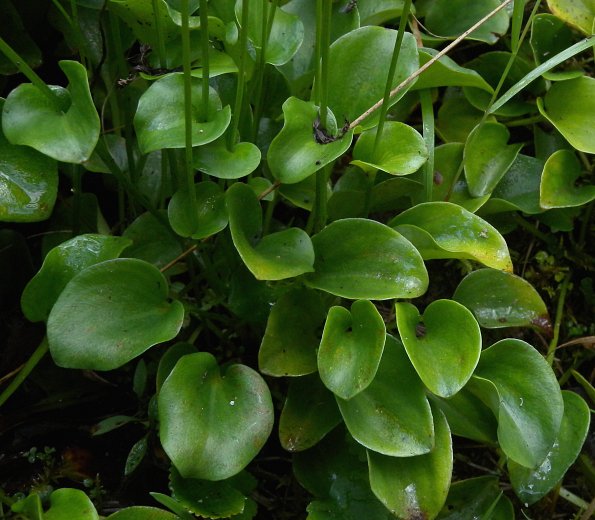
The staminodia are arranged in groups of 3 (rarely 4 or 5) near the base of each petal; the white filaments of each group of staminodia are joined together at the base. At their apices, the staminodia have tiny nectar-producing glands that are light green and globoid in shape. The filaments of the staminodia are shorter than the filaments of mature stamens. The sepals are green and oblong-oval in shape; they are much smaller than the petals. The ovary is ovoid in shape and it has a sessile lobed stigma at its apex. The blooming period occurs from late summer to early autumn, lasting about 3 weeks. Afterwards, the flowers are replaced by seed capsules that are 8-10 mm. (about 1/3") long at maturity. These capsules divide into 3-4 parts to release numerous tiny seeds that can be blown about by the wind. The root system at the base of plant is short and fibrous.
Cultivation: The preference is partial to full sun, consistently wet to moist conditions, and calcareous soil containing organic matter and some gravel or sand. This wildflower tolerates only limited competition from other plants.

Range & Habitat: The native Grass-of-Parnassus (Parnassia glauca) is found in the northern half of Illinois (primarily in the NE), where it is rare to uncommon, while in the rest of the state is largely absent (see Distribution Map). Illinois lies along the southern range-limit of this species. Habitats include grassy fens, marly borders of lakes, sand flats along Lake Michigan, gravelly hillside seeps, and low areas along springs on rocky hillsides. This wildflower is found in high quality natural areas.
Faunal Associations: The flowers are visited by a variety of insects; this includes Syrphid flies, Tachinid flies, other flies, Ichneumonid wasps, butterflies, and miscellaneous bees. One of the flower-visiting bees, Andrena parnassiae, is a specialist pollinator (oligolege) of Grass-of-Parnassus (Parnassia glauca). Most of these insects feed on the easy-to-access nectar of the staminodia, although some of the short-tongued bees also collect pollen from the flowers for their larvae. It has been found in Canada that trampling by White-tailed Deer in wetlands, where Grass-of-Parnassus occurs, tends to increase the abundance of this wildflower, probably by reducing competition from other plants (Pellerin et al., 2006). In some areas of northeastern United States, Grass-of-Parnassus is one of the indicator species for the presence of the Bog Turtle in wetland habitats (Zappalorti et al., 2015).

Photographic Location: A gravelly hillside seep at Turkey Run State Park in west-central Indiana.
Comments: Because of the green-veined petals of its flowers, Grass-of-Parnassus (Parnassia glauca) is an easy plant to identity in Illinois. While there are other Grass-of-Parnassus species (Parnassia spp.) in the United States and Canada, they don't occur within the state. In general, these various species can be distinguished from each other by the size of their flowers, the presence or absence of green veins on the petals of their flowers, the number of staminodia on their flowers, and the relative length of the filaments for fertile stamens versus staminodia. Sometimes Parnassia glauca is referred to as Eastern Grass-of-Parnassus to distinguish it from these other species. The leaves of another wetland wildflower, Marsh Marigold (Caltha palustris), are similar to those of Grass-of-Parnassus, except they have fine teeth along their margins, while the leaves of Grass-of-Parnassus are smooth and toothless along their margins. The flowers of Marsh Marigold bloom during the spring and they are yellow. The common name of Parnassia glauca, "Grass-of-Parnassus," is rather odd because it is not a grass, nor do its leaves even resemble those of grass.